TENNESSEE TILLY in Johnson City -- The Little Club That (Finally) Could
- Dooner
- Oct 6, 2022
- 17 min read
Updated: Jun 26, 2024
FOREWORD: Johnson City Country Club holds the distinction of being the only original A.W. Tillinghast design that still exists in the state of Tennessee. Over the past few years, a passionate few led an effort to revitalize the course in the spirit of it's original architect's design principles. The Golf Crusade has had the great privilege to be a fly on the wall during the process; assisting them in documenting the past four years of the grassroots effort by club leadership to get to this point. It is with great pride and a humble keyboard that we share with you the reimagining of this 100+ year old club.
Due to the length of this this story and the large amount of visual content within it, it is recommended you view this piece on a computer (or a screen larger than a mobile device).

We have been fortunate enough to call Johnson City home for the past decade. It has exceeded every expectation we could have had prior to moving here. We'd never been here before, but knew of the region for only a few reasons: racing at Bristol Motor Speedway, East Tennessee State had a really good basketball tradition, Johnson City was mentioned in a couple songs I liked, and golf.
Golf?

The Tri-Cities (now commonly referred to as the Appalachian Highlands) of Northeast Tennessee and Southwest Virginia is home to around half a million people. It's a predominately rural area, anchored by three main cities: Bristol, Kingsport and Johnson City. Believe it or not, there is some pretty darn good golf here.
In fact, Golf Digest once named it the second best metro region for golf in the United States (August 2005)!
The public golf is a bit spread out due to the fact that finding suitable land for 18 holes can be a slight challenge. It's not all mountain golf however, as a few golden age courses still exist today. Furthermore, people have been golfing in the region since the late 1800s.
Each of the three main cities has what most consider to be a 'local' country club, i.e. the type of place you can afford to join and play because you live close by. Bristol was first to tee it up in the state of Tennessee, founding the (now named) Golf Club of Bristol in 1894. That club - as many others have had to do over the years - moved it's course to the outskirts of town as cities expanded.

The same can be said for Kingsport. In 1919, they too hired Tillinghast to build a 9-hole course. It remained until 1953 when it was plowed under in the name of housing needs (the Green Acres neighborhood sits atop the site today).
On a different site, Donald Ross designed The Ridgefields in the late 1940s, though there isn't much Ross left in it today, aside from the routing.
Johnson City Country Club was built in 1913 on a knoll just east of downtown in what is now known as the Gump Addition (a neighborhood for you out-of-towners). Similarly, it's members hired Tillinghast while he was in the area working on Kingsport CC to design them a new 18-hole course only a couple of miles east of their original site.

Nine holes were built immediately (what is now the back) and the new JCCC opened for play in 1919. The other holes were not added until much later - three more holes in late 1940s (current holes one, two and three) with the final six (current four through nine) coming in the 1950s courtesy of Tennessee architect Lon Mills, who used much of Tilly's planned routing through the western portion of the property.
Upon completion of the full eighteen holes, the course was rerouted. The original opening trio of holes became sixteen, seventeen and eighteen, creating a memorable 'Amen Corner-esque' finish. Old holes four through nine became ten to fifteen and the 'new nine' became the front nine.
Each side opens with parallel par fours from adjacent elevated tee boxes, found just a few steps outside the golf professional's shop. The addition gave the course its three distinct sections over its compact 117 acre tract:

Holes 1-3 and 10-15 play in a basin to the North & East of the clubhouse
Holes 4 through 9 group together on the most severe topographical section of the property to the West of the clubhouse, where a few blind shots come into play
Holes 16, 17 & 18 sit to the South of the clubhouse with mountain vistas from the (drivable par four) 16th tee and 18th green
Tipped out, the course plays to about 6400 yards. Despite a few modest hills, is extremely walkable thanks to its short green to tee distances and compact parkland routing. One could imagine the walk you embark on today would have been exactly the way Tilly had envisioned it over one hundred years ago.

Though the walk may be the same, the course had evolved (or de-evolved in some cases) over the years. It went through phases - as so many board member led courses do - that mirrored the trends of the day. In World War II, budgets were strapped, so bunkers disappeared. When times rebounded, so did the club. Pools were added, as were tennis courts and grander ballrooms in the clubhouse. Priorities shifted over time, as did improvements in technology.
It's amazing to think that the advent of Color TV finally allowed the viewing public to see how truly amazing PGA Tour courses were versus how they appeared in black and white! Most namely among them, of course: Augusta National. Green Jacket envy led to a lot of clubs abandoning their original character they'd spent decades accruing in favor of high-flashed white walls of sand like they'd seen on the tube. JCCC was no different.
The club hired GCA John LaFoy (Greenville, SC) in the 1980s to renovate the course with new bunkers and greens. John was kind enough to speak to us a couple years back. The work had been so long ago and he's since retired, but he clearly recalled to us the time period where the 'everyone wanted to be Augusta' phase was alive and well.

LaFoy's work turned out to be the last major construction undertaken on the course for more than 30 years. If you're familiar with bunker lifespans, you would note the course was approaching forty years of wear, tear and washouts on the gigantic sandy hazards. If you played the course, you'd notice very clearly that - at a minimum - a bunker rehabilitation was long past due.
So if a bunker renovation (at the very least) was in order, what do you do on a limited budget?
A look at the 3rd green complex pre-LaFoy reno (1981 scorecard that was printed with the photo inverted horizontally (thus the weird lines in the text at the bottom that we flipped around the correct way) vs. thrity-one years later.
Tillinghast certainly had a couple of different styles depending on the cash with which he was given to work. On one hand, there is the world-class, all-time great bunkering you see at places like Bethpage, Winged Foot, Philly Cricket and Baltusrol. Don't forget, ol' A-Dub has design credit at Pine Valley too!
On the other hand, you've got Tilly's "local" courses like Niagara Falls CC and Johnson City CC where the bunkering was more restrained. Check out the side-by-side between the two of what NFCC has today that is quite similar to a historical aerial of what is now JCCC's 13th hole that was discovered during this process.
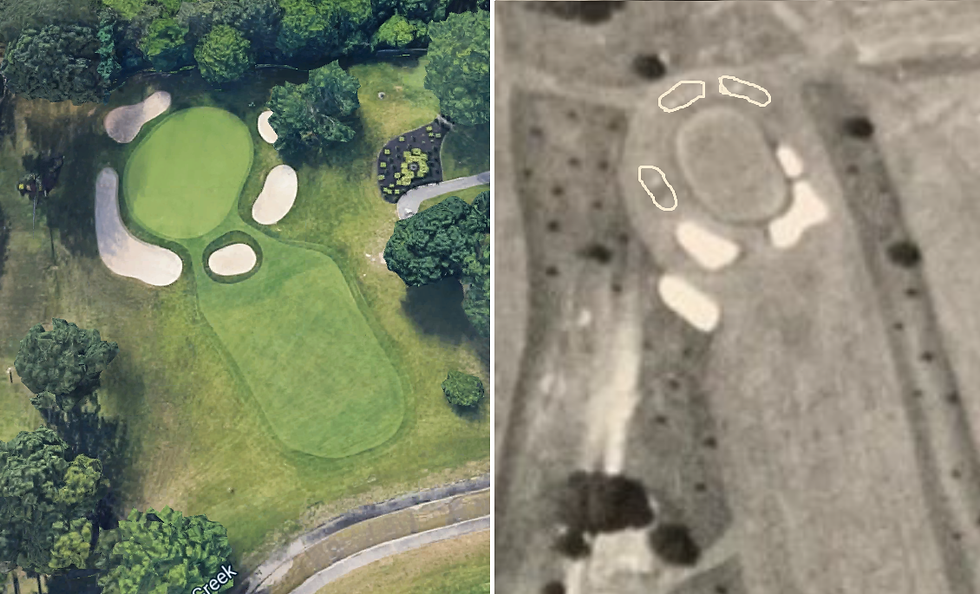
While such a practice today would be almost unfathomable, based on the oldest course maps available, it was clear that LaFoy was not plowing under Bethpage Black. Tilly's local layout was indicative of a smaller budget and frankly speaking, wouldn't necessarily be worth restoring to what could be only in theory be traced back to an original plan drawn by the man (one which was never and probably will never be found).
That said, the club certainly has great value as Tennessee's only surviving original Tillinghast design, a healthy membership that deserves to see this hidden gem polished and the timing and commitment to make it happen.
So, if you don't have original plans (like ones drawn by Tilly himself) and what you can find in the archives is cool, but maybe lacking a wow factor that makes you say, "let's put it back just like this", what do you do?
You can look to some of Tillinghast's other designs for inspiration!
Take the first hole at Johnson City CC for example.
Here's a look at an aerial view from the late 1960s...

Now, let's look at one of AW's most famous courses,
one he designed AFTER Johnson City Country Club!

The layout is nearly identical, sans bunkers. So what if we added some?

Same design. Same architect. Simply 'finished' by adding Tillinghast features!
Since the 10th is right next door to #1, let's consider that hole next. In our research, we found it 'could' look and certainly sounds a lot like the
11th hole at the West Course at Winged Foot.
Here's the description of the hole from Winged Foot's website:
"This is a straightforward hole of moderate length, with a relatively manageable green. The appeal of this hole is in the terrain. The view from the tee, which sits well above the fairway, is as beautiful as a parkland course can offer. Here is the poetic yet hyperbolic description in the 1923 Opening Program, “The 11th,” it said, “is a no-man’s-land hole where something volcanic has happened to the terrain.” The golfer, it continues, looks down “on a fairway humped and ridged at all angles.” The vista includes “a deep gully midway about which criss-cross rolls play like mid-ocean waves.”
Aside from being a longer hole (was originally a par-5), Winged Foot's description could have very well been written for the 10th hole at Johnson City! Again, keep in mind Winged Foot came along four years after JCCC.
If we put Philly Cricket 9 next to Winged Foot West 11, here's what we'd have:

Now, here is a recap of the work done to date at Johnson City CC for Holes 1 & 10:
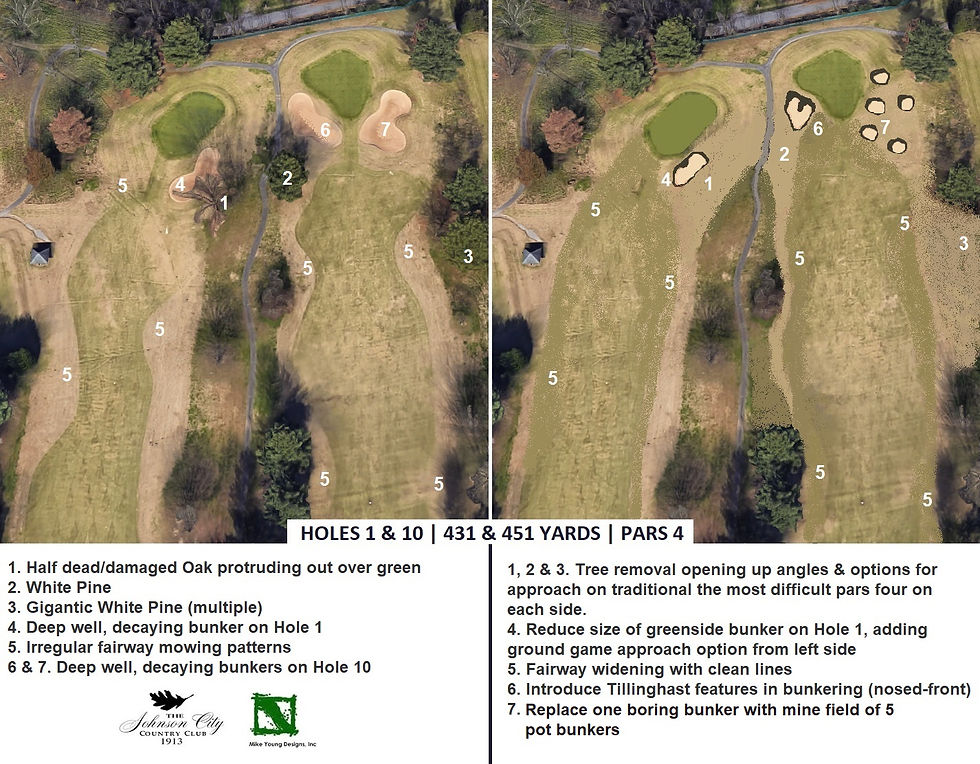
Exact replicas? No, but clearly the same DNA. Inspiration > Restoration

Before we get to rest the trees and bunkers though, you might be wondering how 'this process' actually started. Even if you weren't wondering (FYI it's a big part of the story!), we're going to tell you anyway!
January 6th, 2019 - probably just a typical winter day in Johnson City. The Golf Crusade hadn't yet had it's first birthday and - since Instagram didn't make so challenging to find things relevant to your interests yet - you could actually find neat stuff in your scroll. During one of those nightly scrolls, something caught my attention. I retreated back up a few posts to see if my brain was correct to fire a signal to my right thumb to pause.

Sure enough, the double take was worth it.
Immediately after picking my jaw up off the floor, I sent @brianmnc - aka Brian Marion - a DM introducing myself and hoping to hear about what was planned at the course I'd consider my home course, which is to say it's in my city and I usually play it a few times a year. (No, I'm not a member, but when you want to play 1000 courses, you can't play the same course all the time! Right?!).
We decided it was best if we just met at the course for a little stroll down Tillinghast Lane.
Brian worked in the golf business at the time and he just so happened to be new(ish) in town. Needless to say, our golf archi-nerd powers formed an alliance that endures to this day.
From the very beginning it was very apparent, Brian was going to get this thing done! He knew the road was going to be long, but the prize at the end was there for the taking.
We set out that first evening in January with a coring tool and scouted for potential former bunker sites. We pulled cores to see what might be hiding under decades of well-intended, if not over-eager greens committee agendas. What did it reveal? That the course is old, had way too many trees, plenty of massive decaying bunkers and that original greens were gone.
That said, through the correct lens and focus, through all the trees, washed out bunkers and dormant Bermudagrass, there could be a rose beneath.
The difference between potential realized or wasted can simply be a matter of focus.
CRUSADER NOTE: Let me throw a footnote in here real quick. I'm a "we" guy. When I say "we" in regards to Brian and I digging through old aerials, obsessively scouring Google Earth for peer examples of what may be hidden underneath decades of soil and grass, texting pics & ideas at all hours of the night when we discover something new... Brian is the WE. All I did was take notes, provide a sounding board and appreciate the journey he allowed me to take with him so that I could help share the story he was creating. I'm just the pen. Brian is the author.
In the first year, things started slow - cutting down a dead tree here or there type stuff. Brian was on the greens committee, but there was a lack of vision from the club as a whole. New leadership eventually arrived, but not for a couple years that could impact major spending, like a bunker renovation.
The first significant project came after Brian moved up to chair the golf committee in 2020. The votes came in 'Yea' to redo the practice facility. Since it came in a little under budget, it also included greenside renovations (a bunker redo, mounding reduction and introduction of a chipping area) to the 15th hole.
A practice facility renovation by Bergin Golf Designs doubled the square footage of the practice green, remade the chipping green and saw the installation of a new all-weather tee strip.
That year also saw the arrival of a new Head Golf Professional in Tyler Deaver.
Tyler came to Johnson City from Athens Country Club in Georgia, a highly regarded Donald Ross course that, like JCCC, underwent a restoration/revitalization project. It was there he met one of their members, golf course architect and Athens resident Mike Young (The Fields in LaGrange, GA among many other projects).

By 2021, with Deaver a year into his tenure and Marion now the elected Club President, the two brought in Young to renovate the 18th hole at JCCC.
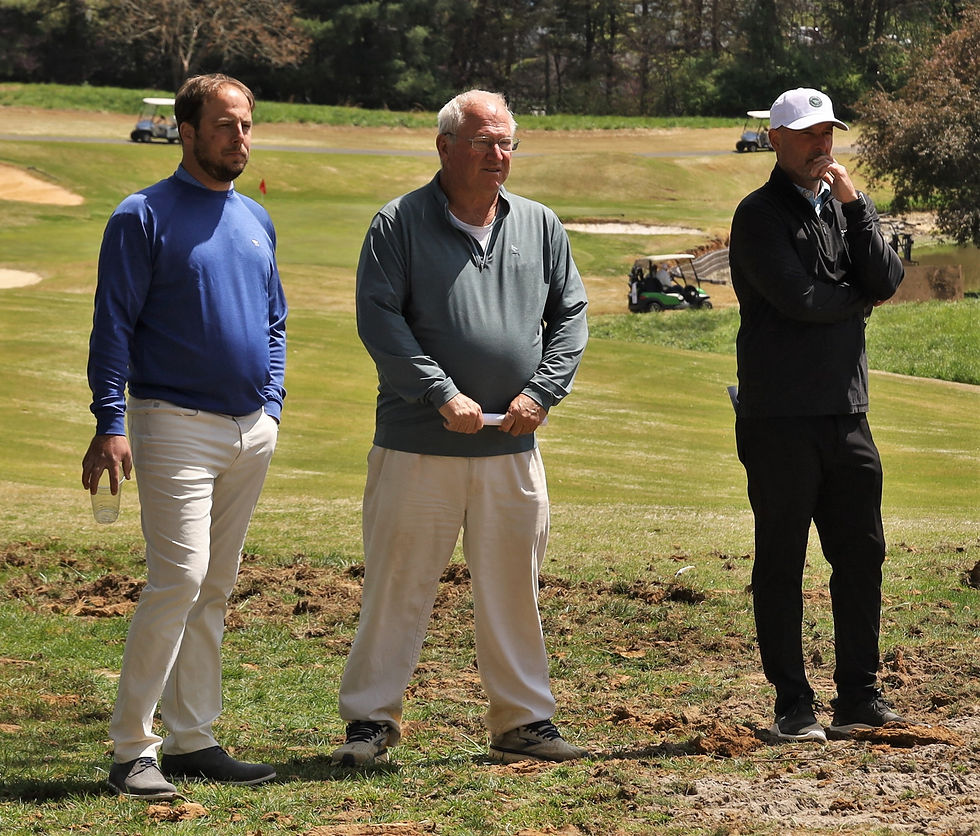
The idea was simple: show the membership what a proper Tillinghast course COULD look and play like.

Playing adjacent to the entrance road, the 18th has the opportunity to make a strong first impression for visitors turning into the club from East Unaka Avenue.
Since the road winds up the hill to the right of the closing hole (over which is out of bounds), Tilly's "Boundary Hole" was an obvious choice to 'reimagine' the hole with his philosophy instead of the original design (which was either lost to Father Time or not interesting enough to recreate - perhaps both). Young broke out the chainsaw on a few trees that had encroached too much into the fairway from the righthand set of tees and replaced them with rough covered mounds, something that Tilly employed to keep slightly off-kilt shots in play versus those that were long gone.
Three bunkers replaced one massive one on the right approach, while two smaller bunkers - one greenside and one fairway - guarded the safer left side. The floor of the bunkers were raised to eliminate the drastic flop shots & blasts that were needed to remove your ball from a sandy purgatory. Capillary concrete liners were installed for the bunkers - which if you've heard of but never seen before, allow us to show you!
"CUT! Reposition the truck and the camera. Quiet on the set! Marker... and ACTION!"
The finished product accomplished many things. First, the new greenside bunkering is stunning to the eye - especially to those making the drive up the entrance road. Next, it reduced the amount of sand square footage to maintain and eliminated washouts in even the largest of rain events.
From a playing perspective, it opened up a plethora of strategic options from both teeing grounds, adding variety to a hole that had become strangled by tree growth and limited pin locations.
Before & After looks at the 18th hole (click on each pair to enlarge)
Lastly, and easily most importantly, it accomplished it's mission to show the membership what this course SHOULD be. To that end, planning began to do the rest of the bunkers the following year. Young would draw up the plans, but not before the fourth key member of the team came aboard. After all, you can renovate as many bunkers as you want, but if no one is there to care for them, you're wasting your time, effort and precious capital.

Steve Foster was brought in as the new golf course superintendent in the summer of 2021, giving the course a trained professional on the maintenance side. A California native, Foster previously stewarded the grounds for RedTail Mountain Golf Resort in Mountain City, TN, a local favorite of ours sadly lost to recession and economic factors far beyond a remedy a golf course could provide.
With the full squad assembled, the economy rebounding and COVID beginning to relinquish its grip, all the signs of the times pointed towards go. Votes were tallied, capital was committed and crew was ready to break ground as soon as Spring sprang.
However... just as you think you've got it all figured out, life has a way to put you back in check. After all, trying times test even the hardiest hearts and minds. Sadly, that was more true than anyone cared to know.

Young, a man seemingly more youthful than his pure white hair and 70 years would indicate, rode in to the doctor's office one day for a routine check-up. He rode out with news of a triple blockage in his heart and a major surgery in his very near future.
Marion, a of couple weeks shy of his 53rd birthday, was having a routine February night at home. Out of nowhere, he started having seizures, despite no history of ever having them. A week and a lot of tests later, both he and his wife, Sarah, a cancer survivor herself, hear the words 'large, malignant brain tumor' all in the same sentence.
Needless to say, the joy for the impending project was replaced with frightening uncertainty. We hurt for our friends and their families knowing the challenging courses that lay ahead.
Neither of the two men is one to put the spotlight on himself. Quite the opposite in fact. Since everything was in place to start moving Earth, the show went on without two of it's key pieces, yet provided even more resolve to those ready to go.
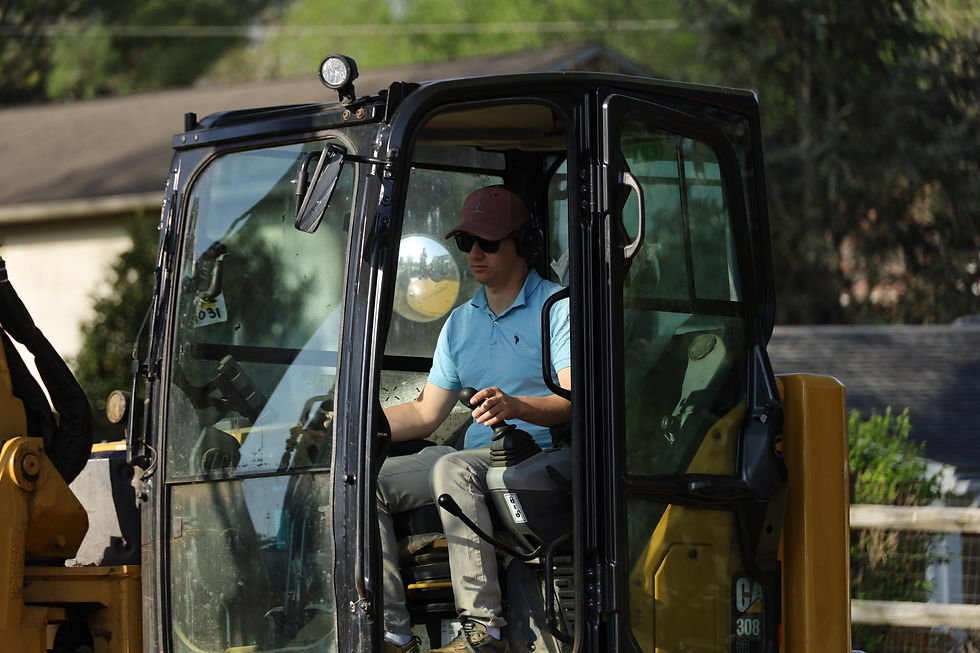
Since Young was unable to travel up from Georgia, up and coming course shaper Ben Malach (whose already impressive resume includes work on Cabot Cliffs, The Nest at Cabot and the South Course at Olympia Fields) jumped in the excavator to do the heavy work. Mike's son, Ashley, whom has spent twenty years working with his father, pinch hit for him, making the drive up weekly. Finally, with Foster and crew handling the finer details around the edges, the project was off to the races.
While Young and Marion were on the mend, the Spring phase of the project began with the 9th green, another first impression opportunity from the back entrance and parking lot. This phase would also include bunker work on 1, 3, 5, 7, 8, 10, 13, 16 and 17. Additional tree work (removal or pruning) was also completed on 1, 2, 3, 4, 5, 6, 8, 10 and 13.
To get an idea of the amount of work that was necessary, you can see the side-by-side views from Google Earth of the before and completed work (which we added to the best of our ability).
See for yourself the actual results of the work as the course sits today (early October 2022). As work continues, we will update this section of the story.
Enjoy a few before and after comparisons.
HOLE 1
HOLE 2
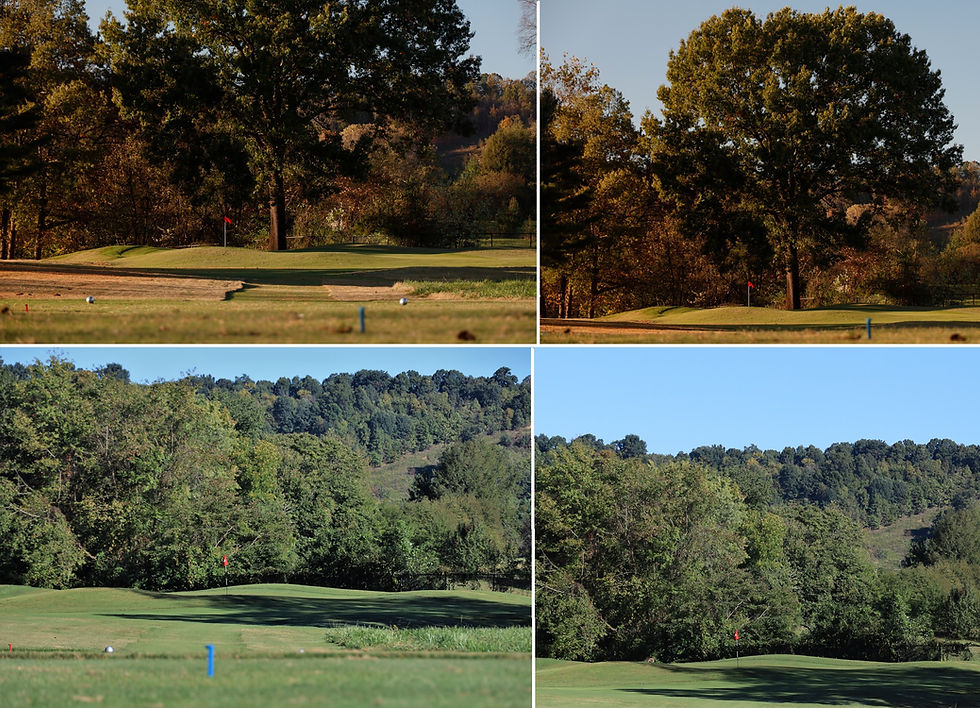
HOLE 3
HOLE 4
While its difficult to see just how enormous those two trees are/were that choked the approach, look at the view from behind the green with an open background behind the two behemoth hardwoods! In the image of the crosscut log, the camera was at eye level (I'm about 6 feet tall). Needless to say, the tree was a danger with no core left.
HOLE 5
HOLE 7
HOLE 8
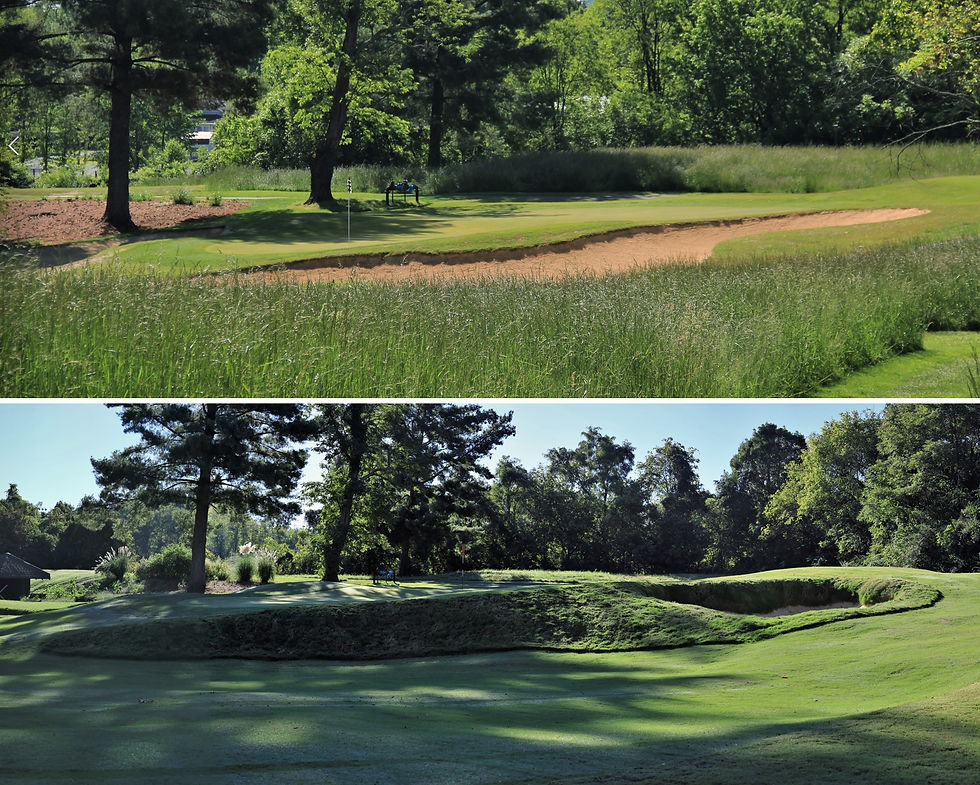
I mean... come on!!! This is so good!
HOLE 9
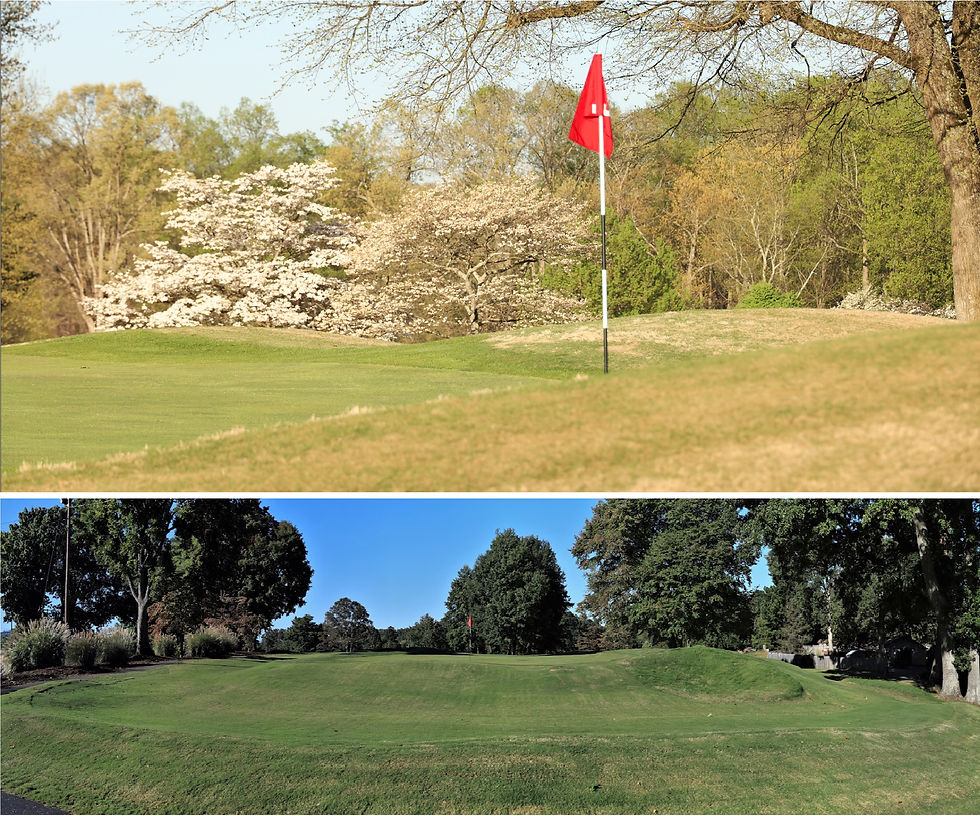
CRUSADER NOTE: During this process, we realized that old 9 was so uninteresting that we'd only ever taken one photo of it in ten plus years of playing it. Truth be told, the above 'before' photo was more about the White Dogwoods than that hole itself. You can also see how how the mounding was behind the green previously and is one of the more dramatic transformations on the property.
HOLE 10
The 10th went from two bunkers to six, yet still reduced the square footage of the sand and added fairway width on the right side around the bunkers where rough-covered mounding formerly dominated the landscape.
HOLE 13
HOLE 15
HOLE 16
HOLE 17
HOLE 18
Finally, a before from the patio above 18 with old 15 in the background followed by the after shot looking the opposite way.

Pivot to the present (Fall 2022) and it's a happier time. Both Marion and Young are recovering, managing their respective battles, and are back to work! Deaver was recently promoted to General Manager at the club and Foster has the course itself looking like its two years post-renovation, not two months!
Ground was broken the last week in September 2022 on the Fall phase of the bunker project. Holes 11, 12 & 14 are on the menu with additional touch-ups to 2, 4, 5 & 6. After getting his feet wet on Phase I, Foster will be piloting the excavator this time, saving the club even more on the budget than they already have (Spring phase came in well under budget yet the results look as if no expense were spared)!
Speaking of budget, the project is currently about 30% under budget and, with the majority of the Phase 1.1 and the rest of Phase 1.2 being handled in-house, is expected to come in even further under the cap.

It's also important to note that the course remained open throughout the project. Of course, the two to three holes that were under construction on a daily basis were skipped for safety precautions and to aid in the speed of recovery/grow-in (which was remarkably fast!). Construction was paused during the summer months while the club held its large events, i.e. The Tillinghast Invitational (regional amateur tourney moved to August from its traditional June date) and tent-pole member tournaments.
If you haven't played it before and you get an invite, take it.
If you haven't played it in quite some time and have the chance to do so soon, seize it.
Aside from the big brands in Bristol, Virginia (two consensus state top 10 courses The Virginian and The Olde Farm, of which the latter was ranked #1 in Commonwealth on Golf.com's 2020/21 list), it is of our opinion that Johnson City Country Club will own the best golf course between Knoxville, TN and Blacksburg, VA.
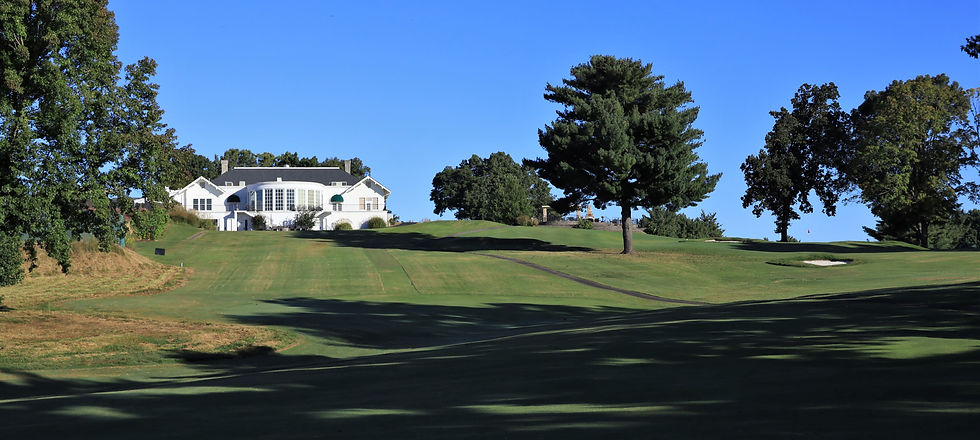
Last September - coming on the heels of a trip down to the beach for The Golf Crusade's signature event, The Iron Maverick - I finally had the chance with my brother in town to play a round together at JCCC, his first. No slouch at the course collecting himself (he's played nearly 150 courses), what the course looked like is still pretty fresh in his mind.
Nearly a year to the day after playing the course, I sent him a gallery of a some photos of the completed holes in the slideshow below (use arrows on sides to navigate).
His response (below that) confirmed our assertation...

Well said, Brother. Well said!
As much fun as it is to see how far the course has come in the past couple years, there is still a lot of work left to do. There are still way too many trees - many of the dreaded white pine variety. This phase also primarily focused on bunkers near the greens. A couple of fairway bunkers were removed, even a fewer number replaced. It's quite easy to see that instead of maintaining or building bunkers, trees were simply planted as hazards in their stead.
Once the trees are out of the way (or at the very least managed), more bunkers can return to the fold.
The greens are not original and approaching 40 years of age, though thanks to Foster they are running as smooth as ever. There is some size and shape to recapture on the outskirts of the green pads, which will allow for some pin positions to return as well.
Perhaps we'll even see Tillinghast's greatest calling card - The Great Hazard - make an appearance in the near future?

Another exciting find in the investigative process was an alternate tee and bunker configuration on the second hole. As it sits now, it's about a 160 yard shot to a bunkerless green, surrounded by mounding that kicks off any less than perfect shot. However, aerials from the 1950s and 60s, as well as an irrigation map found in the maintenance shed, revealed an alternate tee playing a shade over 100 yards.
The tee box is still there, under deep fescue and overgrow limbs, but it's there nonetheless. You can see the lines very clearly in the 1968 aerial photo below, as well as a few from the hidden tee box in 2020.
The ultimate success of the project may not be known for a few years. That said, if the early returns on the golf course are any indication of what that future success may be (retaining current members & recruiting new ones), then perhaps the reimagination of The Tennessee Tilly is all it took for Johnson City Country Club to go from the little club that 'should' be great to be the club that (finally) 'could' be just that.
To learn more about The Golf Crusade, just dig around the site! You're already here, might as well stay awhile! If you like your stories shorter, FOLLOW US @GolfCrusade on Instagram and Facebook! You can also follow our Mike Strantz and Golf Barns themed channels on Instagram. Thank you for visiting & exploring the history of Johnson City Country Club!
Sincerely Fores,
Your Golf Crusade






























































































































































































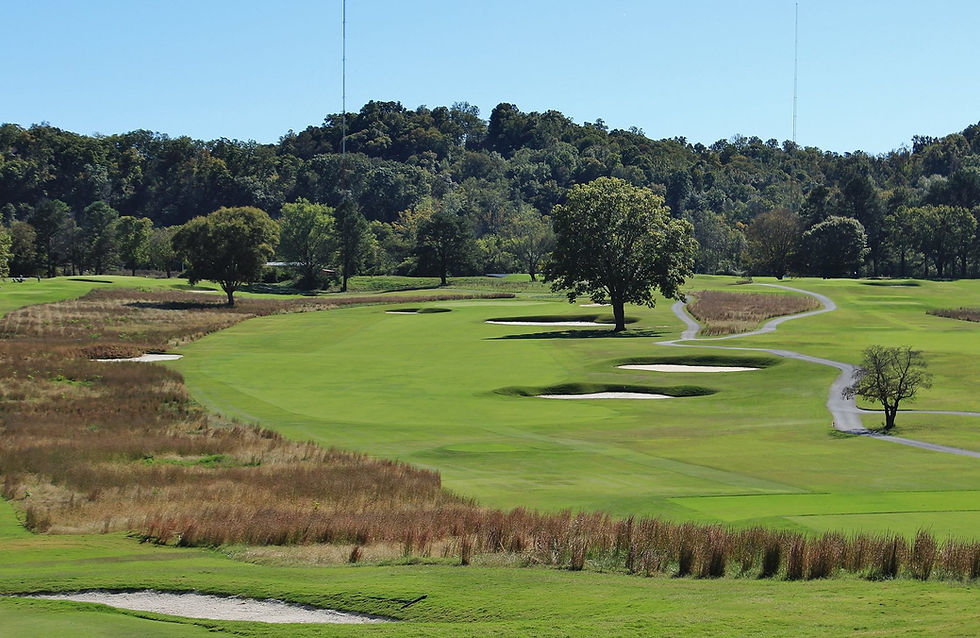
Comments